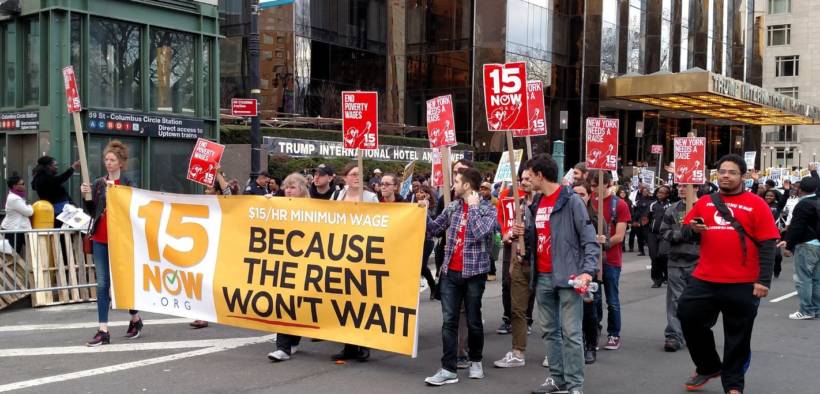Almost Half Of All Americans Work Low Wage Jobs as Praise Heaped on ‘Strong Economy’

“We don’t have any basis or any evidence for calling this a hot labor market.” – Fed Chairman Jerome Powell
Despite strong job growth and a 50-year low unemployment rate, nearly half of all American workers qualify as low wage, according to a Brookings Institute analysis published last month. The report found that “53 million Americans between the ages of 18 to 64—accounting for 44% of all workers—qualify as ‘low-wage.’ Their median hourly wages are $10.22, and median annual earnings are about $18,000.”
The report found that low wages pervade in every regional economy throughout the country, and that they are a major source of economic vulnerability in the population.
“Even though the economy is adding more jobs, there’s increasing evidence that many of those new positions don’t offer the kind of wages and benefits required to get ahead,” reported CBS News. “A new measure called the Job Quality Index recently found there is now a growing number of low-paying jobs relative to employment with above-average pay.”
The Brookings report found that contrary to popular belief, the majority of low wage workers aren’t students or young people, the majority “are adults in their prime working years, and low-wage work is the primary way they support themselves and their families.”
“Workers aren’t shy about expressing their frustrations, with about 6 of 10 workers saying their jobs are mediocre to downright bad, according to a recent Gallup job-quality survey,” reported CBS. “For instance, 1 in 5 workers told Gallup their benefits are worse now than five years ago.”
Low unemployment has contributed to some wage growth in recent years after decades of stagnation. From 1978 to 2018, median worker pay only grew by 11.9% when adjusted for inflation, while average CEO pay for the U.S.’s biggest 350 companies grew by 940% over the same period, according to the Economic Policy Institute.
However, as Fed Chairman Jerome Powell explained in July, despite low unemployment wages are barely growing enough to cover productivity increases and the cost of inflation.
“We don’t have any basis or any evidence for calling this a hot labor market,” Powell said. “We have wages and benefits moving up at 3%, which is good because it was 2% a year ago, but 3% barely covers productivity increases and inflation.”
A Great Time For Investors
Beyond the 50-year low unemployment rating, President Trump has touted the stock market’s record-breaking performance as proof that the U.S. economy under his administration is the “best it has ever been.”
“From stocks to government debt to corporate bonds to commodities, no matter where you went, you reaped a profit this year,” wrote CNBC earlier this month.”The S&P 500 is up more than 25% and counting. Treasurys, which tend to fall when risk assets rally, also gained in 2019. Oil, gold and corporate bonds all scored double-digit returns.”
CNBC attributes Fed policy, including cutting interest rates three times and pumping billions into the financial system, as reason for the stock market’s record performance. Yet despite the tight labor market and impressive stock market, some analysts argue that the reality of the population’s economic situation isn’t reflected by these metrics, as demonstrated by the report showing that almost half of Americans work low wage jobs.
Economist Dean Baker has explained how the stock market is often misunderstood as a measure of the health of the economy. However, the stock market is not the economy, Baker explains, “the stock market is a measure of the expectations of future profits of companies that are listed in the exchange.”
“The basic logic here is simple. The price of Microsoft, Boeing or Pfizer stock is not going to rise because workers are getting pay increases or they can take longer vacations,” wrote Baker. “The price of these companies’ stocks will rise if investors believe that events will cause their profits to be higher. That’s the end of the story.”
For example, Goldman Sachs has recently advised investors to pursue a “low labor cost” strategy, based on targeting industries with low exposure to rising labor costs and avoiding companies where wages are growing, demonstrating how what benefits the stock market does not necessarily benefit the economic well-being of the population. The bank’s strategists believe that if wage growth continues, stocks that are immune to rising labor costs will outperform the market.
While Gallup found 55% of Americans reporting they own stock in April 2019, including individual stocks and stocks included in mutual funds or retirement savings accounts like a 401(k) or IRA, the richest 10% of Americans own 84% of all stocks. With nearly half of Americans excluded from the stock market and the majority of its gains accrued to the country’s wealthiest citizens, critics argue that designing policy centered around the stock market exacerbates inequality and hurts the broader economy.
Baker argues that many policies that would hurt the stock market – stopping Big Pharma price gouging, curtailing fossil fuel production, and allowing labor unions to bargain for better wages – would be good for the economy and broader society. The economist notes that the U.S. had very strong growth with widely shared benefits in the 1950s and 1960s despite stock prices being far lower relative to the economy.
Because these policy changes would improve peoples’ jobs and living conditions, Baker argues that it is important for people to “recognize that reining in bad practices in the corporate sector is good for the economy of the country and the world, even if it is bad for investors.”








“…what benefits the stock market does not necessarily benefit the economic well-being of the population.”
This has ALWAYS been true, but it is never pointed out to John Q. Public by the propagandist “mainstream” media.
Reaganites to this day priase the “strong economy” under Ronnie, the two-bit Hollywood fake. Real wages — the actual buying power of people’s take-home pay — DECLINED nearly 17% under Reagan and Bush I, according to Federal Reserve Bank statistics. Look it up!